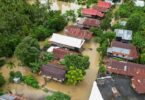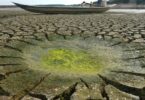ATHENS (Agencies): Firefighters in Greece are battling a reignited wildfire that has triggered a series of new evacuations, as authorities braced for more of the extreme weather that has brought searing temperatures across southern Europe. Authorities had declared the wildfire contained overnight but firefighters lost control when the winds gathered strength.
“It’s day four of these wildfires; they had contained the flames and then as the afternoon progressed, the wind picked up again and that’s when the reigniting of fires happened,” Al Jazeera’s Stefanie Dekker, reporting from near the smouldering ruins of a chemical plant in Voiotia, said. The huge fire has already burned 35 square kilometres (13.5 square miles) of forest and scrubland. In his latest news briefing, Fire Service spokesman Yiannis Artopoios said there had been 62 forest fires across Greece over the previous 24 hours. He added the extreme weather conditions were creating “dynamic fire fronts”, noting that authorities had issued evacuation orders for several areas across West Attica.
Some residents ignored latest the orders to try and save their homes. Chrysoula Renieri, 72, said relatives had helped her try to save the family home near Loutraki, a resort town 81km (50 miles) west of Athens, but the wildfire cut off water in the area. “It’s all gone. We have suffered too much damage,” Renieri said, standing under a blackened and buckled ceiling in the gutted home.
Elsewhere in Greece, a state of emergency was declared on the island of Rhodes, where firefighters were trying to contain a major blaze that also prompted authorities to also evacuation orders for several mountain areas. A major fire was also burning in Laconia, on the southeastern part of the Peloponnese Peninsula. “So far there have been no fatalities, but people are extremely worried,” said Dekker. “There has been international help from the EU sending firefighters and aircrafts to help with dumping water on those areas,” she added.
“But because the land is so arid and the area affected is so vast, it is extremely easy to reignite [the fires].” Stifling heat across Europe’s Mediterranean south created a high or very high risk of fires in Greece, Italy and Spain. Weather forecasts said temperatures could reach 45 degrees Celsius (113 degrees Fahrenheit).
Greek Prime Minister Kyriakos Mitsotakis said the Fire Service and civil protection authority would remain on alert as a new heatwave moved east across the country.
“The hard times are clearly not over yet,” Mitsotakis said. “We are facing another heat wave and a possible strengthening of the winds. So, absolute vigilance and absolute readiness are required over the next few days.” Greek authorities also said that archaeological sites, including the Acropolis in Athens, will be closed during the hottest hours of the day due to a new heatwave. Meanwhile, the World Meteorological Organization said this month that July began with the hottest week on record. The extreme temperatures came after climate change and El Nino – a cyclical weather phenomenon that warms the Pacific Ocean – combined to create the hottest June on record. Europe this week also experienced some of its hottest temperatures so far this summer thanks to a so-called heat dome stretching over its south. A high-pressure anticyclone named Cerberus, a reference to the monstrous watchdog of the underworld in Greek mythology, began moving in from the south on July 10. It was followed by Charon, named for the mythological ferryman who transported souls from the world of the living to that of the dead. That weather system saw parts of Greece, Spain and Italy record temperatures above 45 degrees Celsius (113 degrees Fahrenheit).
The European Centre for Medium-Range Weather Forecasts said that an Atlantic Ocean heatwave reported in early July might have also influenced Europe’s current hot weather. The Atlantic has seen a rise in temperature across most of its basins, especially in North America and Europe. Ocean heatwaves can affect atmospheric circulation patterns and warm the air masses above them. Scientists say climate change, primarily triggered by greenhouse gas emissions mainly from burning fossil fuels, will result in more frequent, severe and dangerous heatwaves. “Climate change across the globe is increasing the frequency, intensity and duration of heatwaves,” Akshay Deoras, a research scientist at the National Centre for Atmospheric Science at the University of Reading, told Al Jazeera.
Cyclones bring stormy weather, and anticyclones are the opposite. They are high-pressure zones in which winds move slower. As a result, they are typically associated with clear, warm weather, but they also have the potential to turn into heat traps. “If a high pressure comes in our region, and if it just moves away in a couple of days, then you don’t get that much heating because that’s just a transient phenomenon. But if it stays longer, then the temperatures go up,” Deoras said.
“That’s what happened last week. There was this high-pressure region that came from North Africa and anchored itself over Southern Europe. Then it went away, and we got another [one] this week, which they called the Charon new heatwave,” he added. Hannah Cloke, a climate scientist also at the University of Reading, described what the phenomenon feels like. “The bubble of hot air that has inflated over Southern Europe has turned Italy and surrounding countries into a giant pizza oven,” she said in a statement. “The hot air, which pushed in from Africa, is now staying put with settled high-pressure conditions meaning that heat in warm sea, land and air continues to build,” Cloke explained.







